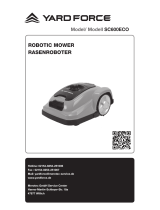• Use the HOME function or switch off the main switch
when persons, especially children or pets, are in the
cutting area. It is recommended to program the
lawnmower for use during hours when the area is
free from activity, e.g. at night. See
Timer on page
21
.
• The robotic lawnmower may only be operated,
maintained and repaired by persons that are fully
conversant with its special characteristics and safety
regulations. Please read the Operator’s Manual
carefully and make sure you understand the
instructions before using the robotic lawnmower.
• It is not permitted to modify the original design of the
robotic lawnmower. All modifications are made at
your own risk.
• Check that there are no stones, branches, tools,
toys or other objects on the lawn that can damage
the blades. Objects on the lawn can also lead to the
robotic lawnmower getting stuck in them and help
may be required to remove the object before the
mower can continue mowing. Always set the main
switch in position
0
before clearing a blockage.
• Start the robotic lawnmower according to the
instructions. When the main switch is set to 1; make
sure to keep your hands and feet away from the
rotating blades. Never put your hands and feet
under the robotic lawnmower.
• Never touch moving hazardous parts, such as the
blade disc, before it has come to a complete stop.
• Never lift up the robotic lawnmower or carry it
around when the main switch is in position 1.
• Do not let persons who do not know how the robotic
lawnmower works and behaves use it.
• The robotic lawnmower must never be allowed to
collide with persons or other living creatures. If a
person or other living creature comes in the
lawnmower’s way it shall be stopped immediately.
See
Stop on page 31
.
• Do not put anything on top of the robotic lawnmower
or its charging station.
• Do not allow the robotic lawnmower to be used with
a defective guard, blade disc or body. Neither should
it be used with defective blades, screws, nuts or
cables. Never connect a damaged cable, or touch a
damaged cable before it is disconnected from the
supply.
• Do not use the robotic lawnmower if the main switch
does not work.
• Always switch off the robotic lawnmower using the
main switch when the robotic lawnmower is not in
use. The robotic lawnmower can only start when the
main switch is set to 1 and the correct PIN code has
been entered.
• The robotic lawnmower must never be used at the
same time as a sprinkler. Use the timer function (see
Timer on page 21
) so the mower and sprinkler
never run simultaneously.
• Flymo does not guarantee full compatibility between
the robotic lawnmower and other types of wireless
systems such as remote controls, radio transmitters,
hearing loops, underground electric animal fencing
or similar.
• The built-in alarm is very loud. Be careful, especially
if the robotic lawnmower is handled indoors.
• Metal objects in the ground (for example reinforced
concrete or anti-mole nets) can result in a stoppage.
The metal objects can cause interference with the
loop signal which then can lead to a stoppage.
• The robotic lawnmower must never be used in
temperatures below 0 °C or above 50 °C. This might
cause damage to the product.
2.3.2 How to lift and move the robotic lawnmower
To safely move from or within the working area:
1. Press the STOP button to stop the robotic
lawnmower. If security is set to the medium or high
level (see
Security on page 22
) the PIN code has
to be entered. The PIN code contains four digits and
is selected when you start the robotic lawnmower for
the first time. See
First start-up and calibration on
page 20
.
2. Set the main switch in position
0
.
8 - Safety 365 - 001 -























